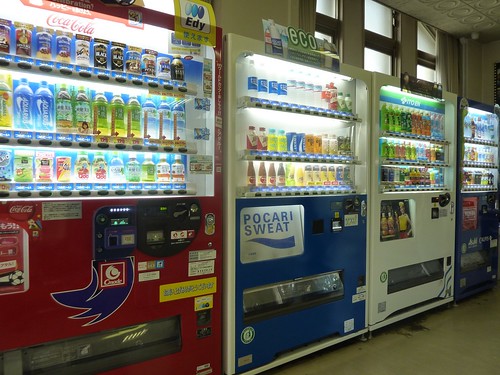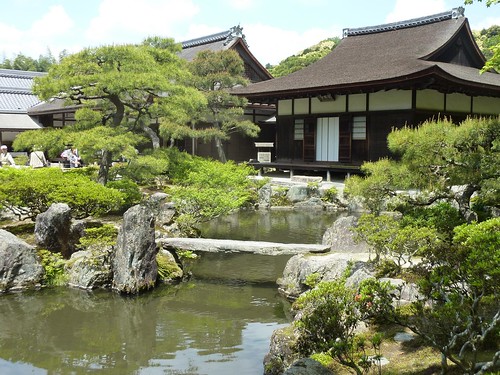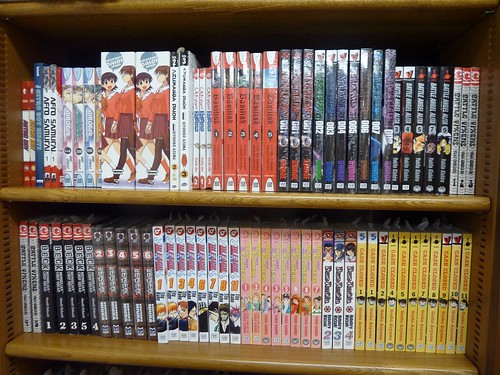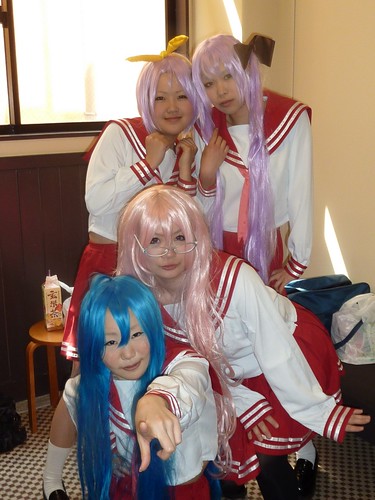It’s broken record time: Japan is GREAT! I love it here! It’s easy and safe and beautiful. And I feel like it’s really starting to get under my skin. For instance when I give money to a cashier I now do so holding it in both hands and with a slight nod/bow. It is received with two hands, and my change is offered in a similar way. I’ve also tried to stop eating and drinking on the street – it’s kind of not done in Japan. Yesterday when I went to a vending machine to get a drink I stood in front of the machine and consumed the whole thing before I moved on. Admittedly this was partly because the contents of the bottle were quite surprising so I was sort of frozen to the spot in contemplation. I thought I was going to get a nice cold orange drink, but it turned out to be a bottle of watery, lumpy orange jello. If McDonald’s orange drink could curdle, that's the texture it would have. Like a lot of things in Japan it was not unpleasant, just unexpected.
 A row of vending machines. They are, I swear, EVERYWHERE. You can be walking down the quietest back street and think to yourself, “Hmmmm, I could really go for a bottle of curdled McDonald’s orange right now.” and as if by magic a vending machine will appear around the next corner. And yes, there is a drink called “Pocari Sweat” – apparently it’s a Gatorade-like sports drink. I haven’t tried it yet, but I’m told it’s nice. And I’ve really only seen machines for drinks and cigarettes so far, nothing really weird like bicycles or live goldfish. I’m told the real vending machine paradise is Tokyo.
A row of vending machines. They are, I swear, EVERYWHERE. You can be walking down the quietest back street and think to yourself, “Hmmmm, I could really go for a bottle of curdled McDonald’s orange right now.” and as if by magic a vending machine will appear around the next corner. And yes, there is a drink called “Pocari Sweat” – apparently it’s a Gatorade-like sports drink. I haven’t tried it yet, but I’m told it’s nice. And I’ve really only seen machines for drinks and cigarettes so far, nothing really weird like bicycles or live goldfish. I’m told the real vending machine paradise is Tokyo.
I saw a lot of temples in Kyoto, though it was only the tiniest fraction of the 1600 Buddhist temples and 400 Shinto Shrines in the city. It didn’t take me long at all before I was completely “templed out”. Actually, it took half a day – the length of the Lonely Planet walking tour of the southern Higashiyama district, though in fairness my tolerance for religious structures of any faith has been extremely low for a long long time now. I quickly instituted a One Temple Per Day policy in Kyoto, and this made things much better. Therefore, I’m only going to tell you about the real highlights as I saw them. First was a small temple called Yasaka-jinji, located in a park that was the halfway point of my walking tour. The temple itself was nothing special, but I happened to arrive right at the start of a wedding ceremony, and I got to see the bride and groom and all the wedding guests arrive and seat themselves. I love it when you happen upon some unexpected real life event like this.
 The bride and groom, with an attendant carrying a red umbrella to shade them
The bride and groom, with an attendant carrying a red umbrella to shade them
By far my favourite temple was Ginkakuji, literally the “Silver Pavillion”. It was originally part of a genteel retreat built in 1482 by the shogun Ashikaga Yoshimasa. It’s a small and exquisitely designed site – a few buildings, a beautiful pond and garden, and the two-level pavillion. It’s compact enough that the whole area can be viewed in detail without too much trekking, and I rented the audioguide, which was excellent. It gave a lot of information about Yoshimasa, who was instrumental in forming what’s known as Higashiyama culture, widely credited with being Japan’s first nationally-shared artistic aesthetic. Higashiyama culture includes things like sado – the tea ceremony, ikebana – flower arranging, Noh theatre, and sumi-e ink painting – many of those things that we tend to think of as typically Japanese.
 Come on, how fantastic is this?
Come on, how fantastic is this?
Ginkakuji is also an example of the Japanese concept of wabi-sabi, which I really like, if I understand it at all, which I probably don’t. It’s a slippery idea for non-Japanese. I think Wikipedia has made a good stab at a definition:
Wabi … connotes rustic simplicity, freshness or quietness, and can be applied to both natural and human-made objects, or understated elegance. It can also refer to quirks and anomalies arising from the process of construction, which add uniqueness and elegance to the object. Sabi is beauty or serenity that comes with age, when the life of the object and its impermanence are evidenced in its patina and wear, or in any visible repairs.
Remember my paper wallet from way back in Barcelona? Well it’s still going, having been taped back together countless times. I think in its current state it’s a decent example of wabi sabi. People comment on it all the time. I don’t mean people say, “Wow, is that wallet ever totally wabi sabi!”, I just mean that when I pull it out people often notice and say it’s interesting, and the Japanese people who’ve commented have agreed that it’s pretty wabi sabi.
I found the whole vibe at Ginkakuji just excellent, and really wished I could banish the zillion other tourists at the sight, hop over the barriers, and wander along the garden paths and across the stone bridges. Instead I tried to tune out the crowds and enjoy the scenery. And of course I stopped to answer the questions of a junior high school boy who waylaid me on the path to the exit. He was on a weekend field trip from a town outside Tokyo, and had the now-familiar questionnaire, which I filled out happily. He even gave me a 5 yen coin in an envelope as a thank you, and we both got photos of us together.
 That thing with the fingers… that’s soooooo Japanese. I see people posing with one hand up like that all the time. Sometimes palm out, sometimes the other way, and often with different combinations of fingers held up. I have no idea what it’s about.
That thing with the fingers… that’s soooooo Japanese. I see people posing with one hand up like that all the time. Sometimes palm out, sometimes the other way, and often with different combinations of fingers held up. I have no idea what it’s about.
Other than viewing some of the compulsory temple and historical sights, I also took some time in Kyoto to explore a part of modern Japanese culture: manga. Manga is the Japanese word for comics or graphic novels, but you really can’t compare the stature and popularity of Japanese manga with their poor Western cousins. Manga is HUGE in Japan – as the LP puts it: “manga stand shoulder to shoulder with traditional text-based books.” On my first night in Kyoto I found a bookstore that had a small section of manga that had been translated into English, so I bought one and dived in.
 Part of the shelf of translated manga
Part of the shelf of translated manga
The first weird thing is that they read back-to-front, because Japanese is written and read from right to left. (They also drive on the left here, but frankly I’ve switched back and forth so many times in the last month and a half that I hardly notice anymore.) This means that the pages are read, in a Western sense, starting with the last page and moving towards the front of the book. It also means that each panel of the comic is read in a different order on the page: top right, top left, middle right, middle left, bottom right, bottom left. Because the artwork and dialogue balloons were originally created in Japanese, it would be impossible to switch it all around, so you read the individual English words in each text bubble from left to right, but the panels are ordered right to left and you turn the pages from back to front. It’s odd, but you get used to it pretty quickly.
The manga I bought was “Hellsing: Vol. 1”, and it was fun – lots of vampires and blood and gore. Most manga are serialized stories, often appearing in short chunks in periodicals and then being bound together into volumes for later sale. And the sheer amount of manga produced, covering every possible subject, is staggering. I learned this when I visited the Kyoto International Manga Museum! This was a four-storey temple of manga. (Note: this site was exempted from the One Temple Per Day Rule). I went on a Sunday afternoon, when the place was full of people sitting inside and out, taking advantage of the enormous manga library. There was a short but informative display on the history of manga (with English translation! Yay!), and a gallery of manga artwork, but mostly it was just shelf after shelf of manga. Oh, and lots of people dressed up like their favourite manga characters. Called cosplay-zoku (costume play gangs), this is a popular activity for some Japanese youth, and because it was Sunday afternoon they were out in force.
 I have no idea who these girls were supposed to be, but they took it pretty seriously. When I asked to take their picture the one in the middle wouldn’t let me do it until she’d put her glasses on.
I have no idea who these girls were supposed to be, but they took it pretty seriously. When I asked to take their picture the one in the middle wouldn’t let me do it until she’d put her glasses on.
As has become my habit, I inadvertently arrived in Kyoto on the eve of a big festival. Aioi Matsuri (the Hollyhock Festival) “dates back to the 6th century and commemorates the successful prayers of the people for the gods to stop calamitous weather. Today the procession involves imperial messengers in ox carts and a retinue of 600 people dressed in traditional costume.” (LP) I planned to take in the procession after my morning walking tour and set out from my hotel in what I thought would be plenty of time to catch the parade at one of its more northerly points. I was going to take the metro and then walk to the parade route, but the hotel desk clerk said I didn’t have enough time for that and I should head straight to the Kami-gamo Jinja, the end point of the procession. I was dubious but went ahead and caught the bus he suggested, which turned out to be a bit of a nightmare. It was packed full of people going to the temple, and was very slow and a bit warm and standing room only. As we crawled through the streets I could just tell that there was no way we were going to get where we were going in time to see the procession pass.
And I was right. Just as we crossed the bridge near the temple, we could see the tail end of the procession disappearing ahead of us. I was pretty annoyed and all for packing it in and staying on the bus for the return journey downtown. Instead, I got off and followed the huge crowd to the temple grounds. There I discovered a sort of fair ground atmosphere with lots of people hanging around and vendors set up selling all manner of weird Japanese fair food. I decided to stick around and see what was going to happen. And of course I had to try some of the food. Most of it was unrecognizable, though I did identify an okonomiyaki stand, and there were people selling shaved ice with flavouring (no way of identifying what flavours, mind you…). The first thing I tried was a perennial favourite – stuff on a stick!
 Squid-on-a-stick! I think it’s a sign of how far I’ve come that I didn’t really consider this as a possible Weird Food.
Squid-on-a-stick! I think it’s a sign of how far I’ve come that I didn’t really consider this as a possible Weird Food.
I sampled few other less-weird things and struck up a conversation with a French woman who was also hanging around. There really weren’t a lot of Westerners there, so it was nice to have someone to talk to even if it was in a combination of my vocabulary-challenged French and her much better English. We chatted together and waited some more – she had it on good authority that there would be some horses going past a some point, so it seemed worth waiting for. I’ve found a lot of travel is like that. The strictly rational, 9-5, work-a-day part of my brain thinks, “You have no idea what’s going on here. There might be some horses going by at some indeterminate point this evening. Big deal. It might not even happen. And if you hang around too long there will just be another crowded, exhausting bus ride back. Bail out now!” Then then casual, long-term traveler part of my brain kicks in and says, “Relax! What else have you got to do anyways? Stick around, and maybe something cool will happen.”
So I stuck, and there were indeed horses. First they were led out of the temple along a wide approach that was lined with reserved seating. Then, one by one, they were raced back towards the temple at a full gallop only to veer off left just in front of the temple gate and right past where I was standing. Ok, it wasn’t high altitude fireworks and aerial ballet or anything, but it was still cool.
And then to avoid the crush on the bus I took a pleasant stroll along the Kamo river. Kyoto’s riverbanks have beautiful, wide walking paths on both banks, and they were full of people out enjoying the warm evening, walking dogs, practicing different sports, and playing musical instruments, it was lovely. There were even spots along the way where large steeping stones allowed pedestrians to cross the river without bothering with bridges. I walked for about half an hour until I reached a convenient subway stop, and then got a quick train back to the hotel.
 What a great system. Mind you, the water was very tame and only about eight inches deep, but still.
What a great system. Mind you, the water was very tame and only about eight inches deep, but still.
It turned out to be a nice evening after all, and that was just one of three I had in Kyoto. There’s still lots more to tell – I participated in a tea ceremony, did origami, learned all about Kyoto’s geisha culture, saw half a show, and ate sushi off a conveyor belt (twice)! But my train has almost arrived in Takayama so that’s enough for this installment. All I can say, once again, is stay tuned.
Small, interesting Japan observation that doesn’t really fit anywhere but bears telling: The buses in Kyoto turned off their engines at red lights, rather than idling.



2 Comments:
"Then the casual, long-term traveler part of my brain kicks in and says, Relax! What else have you got to do anyways? Stick around, and maybe something cool will happen.”
Ah but - leastwise for we uber goal-oriented, impatient, ever-in-a-rush Westerners - this may well be the quintessential blessing/lesson to be learned from long-term travel.
Indeed, for me the epiphany happily kicks in at about 3 weeks on the trail. Would that I could "go there" from the moment my toe hits the foreign tarmac (or better yet, right here in my own backyard!)
P.S. Thanks too, for the delightful enlightenment of "wabi-sabi". I now can rest easy knowing that the dust balls and grunge amid most every corner of my abode - are verily tres chic wabi-sabi! ;)
To me the strangest thing about Japanese vending machines (back in the day) was that they purveyed limitless amounts and varieties of batteries, beer, coffee, juice, tea, soft drinks, cigarettes, CD's, film, vitamin drinks, pantihose, etc., you name it.....but never any candy or snack foods.
A mystery I never solved.
Post a Comment